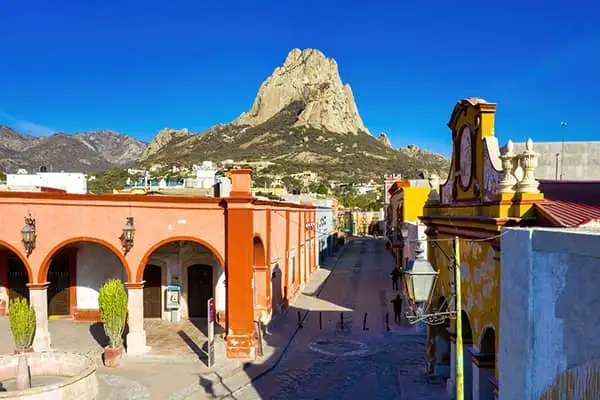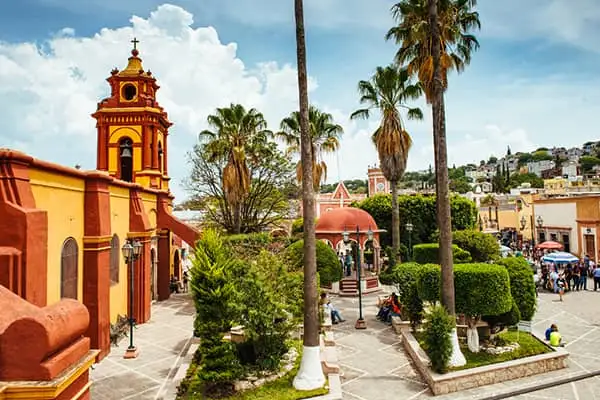I could see Bernal long before I entered this small town in the middle of Mexico’s central highlands. The Peña de Bernal—a towering rock monolith similar to Devils Tower in Wyoming—stands 1,148 feet above its base in the high desert, dominating the landscape for miles around. This volcanic dome is said to be the third-highest of its type in the world, and the tallest freestanding rock in Mexico; it’s certainly a gigantic chunk of rock.
The monolith is the main reason to come to Bernal. Hikers without special skills can ascend most of the way to the summit along a steep, though well-maintained, trail. Climbing the final, vertical 148 feet requires a guide, technical gear, and experience. Adventurers who have made the climb say that the stupendous views of the valley below make it worth the while.
The monolith was sacred to the Indigenous Otomí-Chichimeca people long before the arrival of the Spanish. If you happen to be here on May 4, you can watch their descendants make their annual pilgrimage to the summit while carrying a 187-pound wooden cross in the hopes of bringing rain and divine protection to their people.
The beauty of the Peña de Bernal is one reason why Mexico’s Secretary of Tourism has given Bernal the pueblo mágico, or magical town, designation. Pueblos mágicos are towns distinguished by their natural beauty, culture and traditions, cuisine, arts and crafts, and other unique qualities, and Bernal has an abundance of these features. Even if you don’t come to climb the rock, you’ll still find more than enough diversions to spend an enjoyable day or two.
The Spanish soldier, Alonso Cabrera, founded the town of San Sebastián Bernal in 1642; its population is less than 3,000. Since the monolith is designated as one of the 13 Wonders of Mexico, Bernal plays host to many tourists, especially on the weekends. The majority of its residents are involved in the tourism industry or work at one of the vineyards near the town.
At 6,847 feet above sea level, Bernal has a semi-arid, high altitude climate, and most rain falls between May and September—though even then, there will be plenty of sunny days. Temperatures rarely exceed 85 F, even during the hottest months of March through May. Once the sun goes down, temperatures drop and most nights will be a bit chilly, especially during the winter months, when it might get below freezing. Humidity from December through May is relatively low, averaging 52%. That increases to around 74% during the warmer months. Many cactus species thrive in this climate; some of them grow to the size of trees.
Best Things to See and Do in Bernal

The Peña de Bernal plaza and the adjacent mustard and burnt ochre-colored San Sebastián Temple, located in the center of town, form the hub of Bernal. You’ll find some of the most inspiring views of the monolith from here. The early 18th-century Catholic church, with its colorful exterior, towering belfry, and gracefully domed roof, is a popular location for weddings and photography. The plaza has attractive shade trees and park benches. Shops and cafés catering to visitors surround the complex.
Querétaro, just a 40-minute drive away, is the largest city in the area, and the Queretanos here urged me to try the unique black corn gorditas that are a specialty of Bernal. My driver knew just where to find the best ones—a little hole-in-the-wall restaurant a few blocks off the main drag. Imagine a thick, rustic, doughy, dark-blue corn tortilla that’s been cooked on a griddle like a pancake, split down the middle as you would a pita, then stuffed with meat, cheese, or a combination of the two, and grilled again until it’s warm and toasty all the way through. I had two shredded beef and cheese gorditas—for about $1 apiece, it wasn’t much of a splurge—and the savory taste was fantastic. You can add spicy red or cactus salsas to liven up the flavor, if desired. The proprietor, who was clearly not used to serving foreigners, was thrilled by my reaction.
Other regional specialties include pan de queso, a mildly sweet bread made with local cheese, and dulce de leche de cabra, a deliciously sweet, caramel fudge-like confection made from goat milk and raw sugar. Dulces Bernal has a shop and museum wholly devoted to the artisanal sweets made of milk, seeds, tamarind, and fruit that are produced in this region, though you can buy sweets at the market and in practically every shop in the central district.
Calle Miguel Hidalgo is the main street that leads through the historic center. It’s a picture-perfect walking street, full of little mom and pop shops selling souvenirs, opals, regional handicrafts, clothing, local cheeses, wines, chocolates, and confections. Many of the buildings, including the dusky rose and white Palacio Municipal de Bernal clock tower on the south edge of the plaza, were built in the 19th century, which makes the downtown an especially quaint place to linger.
I found the Centro Artesanal La Aurora, located on the western edge of the plaza, particularly interesting. This shop processes their own wool, and the store is piled high with woolen fabrics, shawls, blankets, and rugs. You can ask to see the on-site looms where the goods are made. Prices are lower than I expected and the selection of products was overwhelming.
The Museo de la Máscara has an interesting collection of more than 300 masks from around the world, including ones from Querétaro State and elsewhere in Mexico.
Bernal has an outsize selection of restaurants for a small town, though as with everything else here, not every place is open on weekdays. If you come on a Friday, Saturday, or Sunday, I recommend having dinner at the sophisticated L'enoteka Wine Bar. Expat friends of mine in Tequisquiapan rave about the quality of the food and the hospitality of the Mexican and German couple who own it.
Most of the side streets in Bernal are constructed with well-worn cobblestones, and the main shopping streets are pedestrian-only. Narrow, bumpy, one-way roads in the central area make getting around by car an often frustrating task, and it’s not surprising to see that many locals use ATVs to get around—though the town is small enough that you can easily navigate it on foot. You’ll find public parking lots on several of the side streets near the small downtown.
Bernal is a stop on the renowned Querétaro Art, Wine, and Cheese Route that passes through the towns of Ezequiel Montes, El Marqués, Tequisquiapan, Colón, and Cadereyta de Montes. Several art galleries, a variety of small shops that sell locally made cheese, and several wineries are within close proximity of Bernal. Vinedos Donado is one of the more popular wineries near town. They offer tours of their vineyards and cellars, as well as wine tasting—sparkling white and rose wines and sweet, fragrant ports are the regional specialties.
It can be difficult to find a winery open to drop-in visitors, especially on the weekdays, so it’s wise to make prior arrangements if you want to indulge in a tasting. If you take an organized art, wine, and cheese tour, the necessary reservations will already be in place. Most of these tours begin in either Querétaro or San Miguel de Allende.
Exploring Bernal
Staying in Bernal

Most visitors to Bernal stay for the day, or for a day and a night. If you plan to be here on a weekend, making advance reservations for lodging is strongly recommended. During the weekdays, Bernal tends to be a sleepy little town, and unless it’s a holiday, you should have no difficulty finding a place to spend the night. Hotels range from budget inns to upscale boutiques. Camping is also an option at one of several campgrounds located near the foot of the monolith. Cool Glamping Bernal offers traditional campsites as well as some plush private domes with king-size beds, Jacuzzis, and close-up views of the rock.
The easiest way to get to Bernal is by taking either a private car or a tour. You can arrange for a ride using Uber or its competitor Didi; from Querétaro, this can cost less than $5 one-way, though it may be difficult to book a ride back home. You can also make arrangements with a private driver, as I did. My driver not only provided the transportation there, but was able to point out some interesting sites along the way, introduce me to the shop with the best gorditas in town, and give me a ride back to my doorstep several hours later.
The Otomí-Chichimeca people believe that the Peña de Bernal monolith is a source of power, and energy rituals, especially during the spring and autumn equinox, attract visitors who hope to take some of that vitality home with them. Whether it’s the energy emanating from the monolith, the fresh, clean, country air, or simply the beauty of this picturesque village, spending time in Bernal just seems to make you feel good. It’s a “can’t miss” destination in Mexico’s beautiful central highlands.
Get Your Free Mexico Report Today!
Get Your Free Mexico Report Today!
Learn more about Mexico and other countries in our daily postcard e-letter. Simply enter your email address below and we’ll send you a free special report – Mexico: The Perfect Close-to-Home Retirement Haven.

By submitting your email address, you will receive a free subscription to IL Postcards and special offers from International Living and our affiliates. You can unsubscribe at any time, and we encourage you to read more about our Privacy Policy.
Related Articles
A Fully Furnished Rental For $800 A Month—Bills Included
